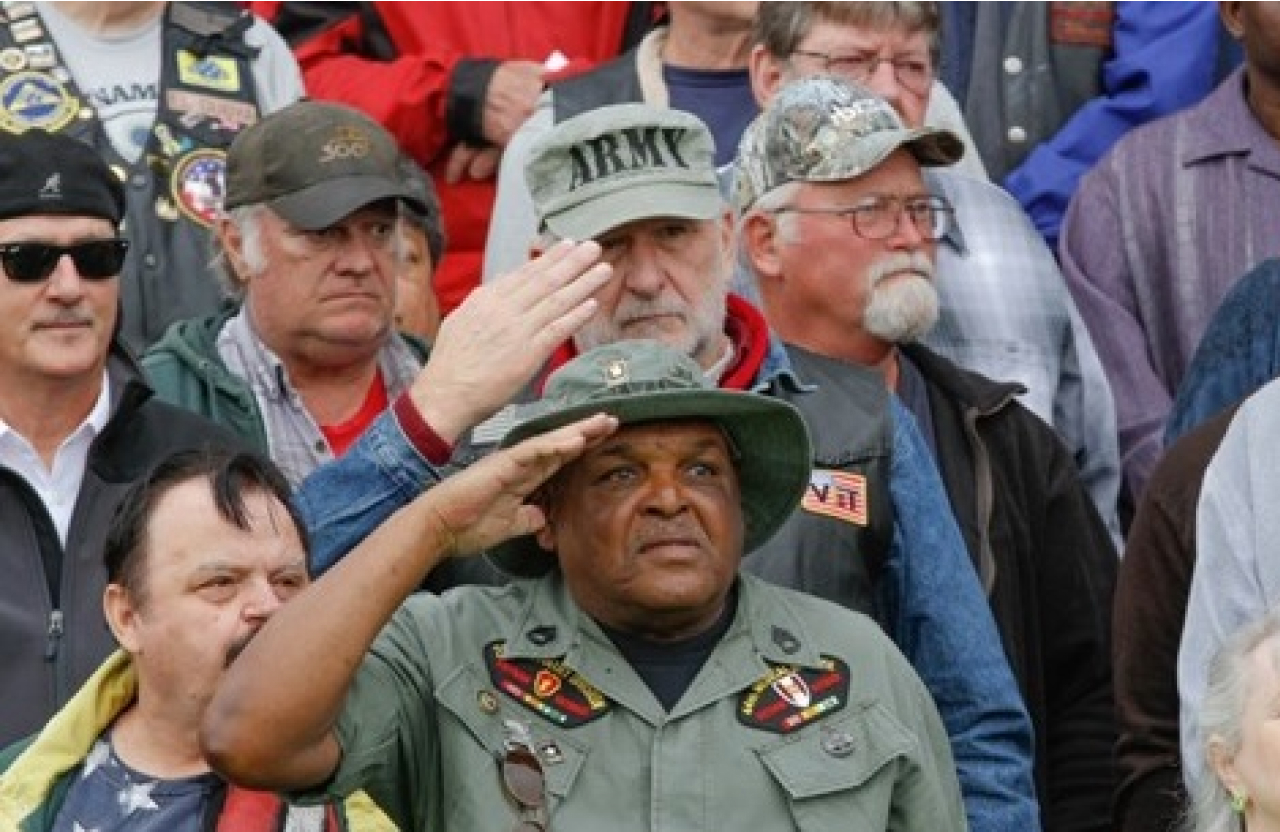The Growing Crisis of Aging Homeless Veterans

By Monica Diaz, Senior Executive Director, Homeless Programs Office, U.S. Department of Veterans Affairs
Posted March 6, 2024
Scientists across the country are issuing a warning about a long-term trend that has been unfolding: the number of older Americans experiencing homelessness is rapidly increasing. Projections indicate that the segment of adults experiencing homelessness who are 65 years or older is set to more than double over the next decade.
This trend has not gone unnoticed by professionals in social services, emergency response and health care. A recent study revealed that homelessness disproportionately affects those who came of age during the late 1970s and early 1980s, born between 1955 and 1965, right after the peak of the post-World War II baby boom. As these individuals entered the job market, they faced stiff competition from earlier Baby Boomers, who were more experienced job seekers.
Veterans have not been spared from the negative impacts of this impending crisis. A detailed analysis by the National Center on Homelessness among Veterans (NCHAV), using administrative data from the U.S. Department of Veterans Affairs (VA), revealed that the number of homeless Veterans aged 55 or older increased by 150% from 2010 to 2023. Moreover, between 2007 and 2017, the proportion of aging Veterans among sheltered homeless Veterans surged by 46%. Multiple studies have underscored that homelessness can exacerbate pre-existing vulnerabilities among aging Veterans. For instance, aging homeless Veterans face elevated rates of mortality and morbidity, including conditions like cardiovascular disease, dementia, orthopedic issues, and oral/dental problems.
Furthermore, according to the Veterans Health Administration (VHA) Support Service Center, nearly half of Veterans in VA health care are 65 years or older. VHA projects that from fiscal year (FY) 2020 to 2035, the subgroup of Veterans aged 85 and older is poised to increase by 66%. Notably, the subset of women Veterans aged 85 and older is expected to see a staggering 159% increase, and the number of Americans with three or more health challenges in the 65 to 75 age group will double. Last, over 60% of Veterans in the Housing and Urban Development-VA Supportive Housing program (HUD-VASH) are 60 or older.
The Response
In response to this crisis’s impact on Veterans, Congress recently enacted legislation that granted the Secretary of VA the authority to fund enhanced services for aging homeless Veterans. Implementation of these enhancements is being jointly led by VA’s Homeless Programs Office (HPO) and Office of Geriatrics and Extended Care (GEC).
VA has identified six essential strategies to address aging homeless Veterans’ housing and service needs. These strategies encompass the use of newly granted authorities under the Joseph Maxwell Cleland and Robert Joseph Dole Memorial Veterans Benefits and Health Care Improvement Act of 2022 (P.L. 117-328), which includes the proposal of interagency and state-level approaches such as preventive health care measures, the expansion of medical respite and hospice programs, the augmentation of affordable housing options tailored to aging Veterans, the enhancement of legal services, and the application of data-driven research to make well-informed decisions.
Strategy 1: Provide preventative health care for aging homeless Veterans to ensure less dependence on emergency visits and less risk of institutionalization.
Efforts to enhance specialized programs catering to homeless adults grappling with complex and chronic health conditions should include requirements to accommodate older adults who are medically fragile and unable to live independently yet do not require hospitalization.
- Expand Homeless Patient Aligned Care Teams (HPACT) sites throughout the VHA system. In FY 2023, funding was allocated to establish six new HPACTs, bringing the total to 62 sites across the country.
- Implement a pilot program in FY 2024 that combines HUD-VASH with the HPACT medical model. This initiative offers in-home primary care services to Veterans enrolled in HUD-VASH at five designated sites. Through comprehensive care coordination, including medical, mental health, and wrap-around services, Veterans participating in HUD-VASH can maintain housing stability as they age, leading to reduced emergency department visits and inpatient admissions.
- Deployed 25 mobile medical units (MMUs) in FY 2023 to provide direct patient care and housing services in community settings. These MMUs are poised to bolster access to health care and support services for the growing population of aging Veterans accessing HPACT services.
- Introduce virtual assessments between physical and occupational therapists and Veterans at Community Resource and Referral Centers, potentially facilitating access to durable medical equipment to aid aging-in-place.
- Facilitate connections between Veterans and various benefits through Grant and Per Diem (GPD) providers. These benefits cover a range of offerings tailored to aging Veterans, including Social Security Administration benefits, VA benefits, VA Home Based Primary Care, and VA geriatrics clinics.
- Make the inclusion and expansion of Health Care Navigation services for all Supportive Services for Veteran Families (SSVF) grantees mandatory.
- Implement SSVF’s Shallow Subsidy service tailored to the aging population. Approximately 50% of recipients of this service are aged 55 or older. Prioritizing Veteran households with stable yet limited fixed incomes, such as Social Security, Social Security Disability, and service or non-service-connected pension, directly benefits the aging population SSVF grantees serve.
Strategy 2: Expand medical respite programs and hospices for aging homeless Veterans who need additional medical services.
These actions are instrumental in offering rest and recovery to homeless older adults, effectively reducing the cycle of recurrent visits between the emergency room and life on the streets.
- In FY 2023, launched a Medical Respite Pilot Project. This project introduced a short-term residential and person-centered care model called Medical Respite, designed to provide Veterans with a safe environment to rest while accessing essential medical care and other support services. Eighteen new medical respite contracts through Health Care for Homeless Veterans are currently under development, and an additional seven VA Medical Centers (VAMCs) have sought funding for contracts in FY 2024.
- Increase support for GPD Hospital-to-Housing. The GPD hospital-to-housing model is tailored to Veterans experiencing homelessness who are identified and assessed in inpatient care and emergency departments. These Veterans are then transferred to GPD transitional housing programs equipped with supportive care. An HPACT or an appropriate care team will oversee each Veteran’s ongoing health care needs during their stay in transitional housing. In FY 2024, GPD has 25 hospital-to-housing grantees and is providing up to 216 beds for homeless Veterans.
- Develop a new pilot grant program within GPD. This program aims to offer grants to hire trained professionals who can support current and formerly homeless Veterans in various activities of daily living, encompassing fundamental tasks necessary for self-care.
Strategy 3: Increase access to affordable housing for aging Veterans
As per research conducted by the National Alliance to End Homelessness Research Institute, there has been a noticeable rise in the number of older adults experiencing homelessness. This situation requires expanding and adapting our current service systems to effectively meet the unique needs of this demographic (Connecting Older Adults to Housing: Examining Disparities - National Alliance to End Homelessness).
- Provide technical assistance and education. HPO and GEC are actively providing technical assistance and educational resources to staff working in homeless and GEC programs. This effort aims to enhance access to care and services, focusing on non-institutional and community residential care programs.
- Collaborate with local public housing agencies to increase the utilization of HUD-VASH vouchers in Special Housing Types that offer supportive services in specialized care settings. These settings encompass congregate care, single-room occupancy, group homes, shared housing, and assisted living facilities.
- Develop more project-based housing to bolster site-based, multidisciplinary care within permanent supportive housing locations.
- Leverage home health services contracts and state partnerships to ensure housing stability for more extended periods as Veterans age in place. Also, during FY 2024, efforts will be made to encourage some local and state levels of engagement. The aim is to designate specific beds for aging homeless Veterans and eliminate eligibility and administrative barriers, facilitating immediate access to essential services and housing for this vulnerable population.
Strategy 4: Enhance outreach to aging Veterans involved in the criminal legal system
In the United States, the demographic of older adults is experiencing rapid growth within the incarcerated population. Many older individuals are expected to be released from jails and prisons and reintegrate into their communities. Unfortunately, older adults in incarcerated settings confront accelerated aging, heightened rates of disability, and cognitive decline. These challenges are often attributed to inadequate health care and the traumatic experiences they endure while incarcerated.
- Enhance outreach and engagement by Veterans Justice Programs (VJP). VJP actively engages law enforcement, courts, jails, and prisons to identify Veterans within the justice-involved population. This outreach connects them with clinical services tailored to their specific health care needs.
- Increase attention on Veterans with a history of sexual offense. A particular focus within the VJP strategy is placed on Veterans who are required to register as sex offenders. This group constitutes a significant portion of older incarcerated Veterans and faces unique housing challenges stemming from their registry status. Additionally, they share housing challenges with Veterans who are homeless and have criminal records.
- Provide national education and disseminate best practices. VJP aims to share best practices for serving older justice-involved Veterans nationally. This involves fostering local partnerships between VJP, Area Agencies on Aging, the American Association of Retired Persons, and local legal providers. These collaborations are instrumental in supporting competency evaluations for fiduciary and conservatorship needs.
- Enhance collaboration to identify housing solutions. VJP collaborates closely with the HUD-VASH and GEC program offices to educate staff about the unique needs of older incarcerated Veterans and to establish pathways to permanent housing for these Veterans as they transition out of incarceration.
Strategy 5: Utilize data and research to make timely and informed decisions
Aging is a focal point of extensive research within NCHAV. There are numerous ongoing projects, both internal and external, including, but not limited to:
- Direct the focus of data analysis through grant proposal development. NCHAV analyzes data extracted from VA medical records to identify aging Veterans’ distinct medical and mental health requirements. Concurrently, there are plans to submit a grant proposal to VA’s Health Services Research & Development Service. This proposal seeks to conduct a multi-year evaluation of HUD-VASH’s ongoing initiative, which provides enhanced services to aging Veterans residing in project-based supportive housing sites.
- Prioritize research on aging homeless Veterans. NCHAV recognizes the urgent need to address the unique requirements of aging Veterans who are grappling with homelessness. They have made this demographic a priority area within NCHAV’s intramural grant program as part of their commitment.
The Work Ahead
We are at a pivotal moment in the national housing and homelessness crises. This moment demands bold and decisive action to ensure that as Veterans age, they are supported in ways that appropriately address their health care needs, honor their choices, and preserve their dignity.
We won’t rest until every Veteran has a safe, stable, accessible, and affordable home—and can ensure no Veteran experiences the tragedy and indignity of homelessness ever again.



















